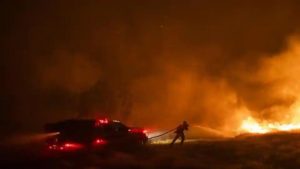Using bulldozers and hand tools, crews scraped fire breaks into the earth to block flames from around 24 major blazes sparked by dry lightning during a record heat wave.

Higher humidity and gentler winds helped firefighters get a grip on the fires, but temperatures and winds were expected to pick up in coming days.
Over 14,000 firefighters from half a dozen states carved out containment lines around some of the largest wildfires in California history on Tuesday, helped by cooler temperatures.
Using bulldozers and hand tools, crews scraped fire breaks into the earth to block flames from around 24 major blazes sparked by dry lightning during a record heat wave.
The worst fires, now the second and third largest in state history, burned in the greater San Francisco Bay Area and 136,000 people remained under evacuation orders.
Higher humidity and gentler winds helped firefighters get a grip on the fires, but temperatures and winds were expected to pick up in coming days.
“The weather has really cooperated with us. We are steadily getting a trickle of new resources in,” Cal Fire Operations Chief Mark Brunton said of a blaze north of Santa Cruz.
Four people were still missing after the fire known as the CZU Lightning Complex destroyed 330 homes and other structures, Santa Cruz County Sheriff Chief Deputy Chris Clark told reporters.
Some authorities blamed climate change for the fire in an area of coastal rainforests that do not normally burn.
Since the dry-lightning siege began Aug. 15 over 650 fires have torched more than 1.25 million acres (505,860 hectares) in California, an area larger than the Grand Canyon.
At least seven people have died and over 1,400 homes and other structures have been destroyed, with losses possibly rising to over 3,000 structures, Cal Fire Assistant Deputy Director Daniel Berlant said in an online briefing.
Livestock owners evacuated animals to the county fairgrounds in Santa Rosa to protect them from a monster fire burning in hills 20 miles to the east.
“If we get strong winds from an unexpected direction anything can happen,” said Kathleen Haase, 45, a farmer from Guerneville who evacuated 200 goats after three of her neighbors lost their homes.
Firefighters cut a containment line around a third of the fire dubbed the LNU Lightning Complex, which is the third largest in state history at over 350,000 acres.
To the south, containment ticked up to 15% on the state’s largest fire, in hills 10 miles east of San Jose.
Thousands returned to homes in Santa Clara County as some evacuation orders were lifted around the fire known as the SCU Lightning complex.
Smoke from fires created unhealthy air quality for a large swath of Northern California, with many San Francisco residents staying indoors.
Governor Gavin Newsom on Monday said California was facing “a different climate” after record temperatures siphoned off moisture from storms to create dry-lightning.
The state’s five largest wildfires have burned in the last three years, the largest of which was the Mendocino Complex fire in 2018 which blackened 459,123 acres.
A two to three degree Fahrenheit rise in average temperatures, combined with insect infestations, have created more dead trees and parched brush that act as kindling to supercharge fires that have long burned in California, according to bioclimatologists.

